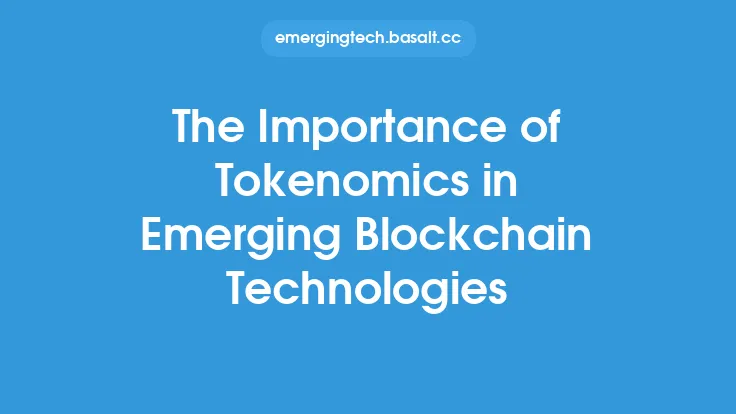The blockchain ecosystem is a complex and multifaceted space, with various components working together to create a secure, decentralized, and efficient network. At the heart of this ecosystem lies tokenomics, the study of the economics and design of tokens, which are the native assets of a blockchain. Tokenomics plays a crucial role in shaping the behavior of participants, influencing the overall health and stability of the network, and determining the long-term success of a blockchain project. In this article, we will delve into the interplay between tokenomics and blockchain architecture, exploring how the design of a token and its underlying economics interact with the technical infrastructure of a blockchain.
Introduction to Tokenomics
Tokenomics is a relatively new field of study that has emerged in response to the growing importance of tokens in the blockchain ecosystem. It involves the analysis of the economic and social dynamics of tokens, including their creation, distribution, and use. Tokenomics encompasses a broad range of topics, from the design of token economies to the study of token price movements and the impact of tokens on network behavior. By understanding the principles of tokenomics, blockchain developers and users can better navigate the complexities of the ecosystem and make informed decisions about token design, distribution, and use.
Blockchain Architecture
Blockchain architecture refers to the technical infrastructure of a blockchain, including its network topology, consensus algorithm, and data storage mechanisms. The architecture of a blockchain plays a critical role in determining its scalability, security, and usability, and has a direct impact on the performance and functionality of the network. Blockchain architecture can be broadly categorized into two types: permissionless and permissioned. Permissionless blockchains, such as Bitcoin and Ethereum, are open to anyone and allow for decentralized decision-making, while permissioned blockchains, such as Hyperledger Fabric, are restricted to authorized participants and are often used in enterprise settings.
The Interplay Between Tokenomics and Blockchain Architecture
The interplay between tokenomics and blockchain architecture is complex and multifaceted. On one hand, the design of a token and its underlying economics can have a significant impact on the behavior of participants in a blockchain network, influencing factors such as network congestion, transaction fees, and mining incentives. For example, a token with a high velocity, such as Bitcoin, may lead to increased network activity and higher transaction fees, while a token with a low velocity, such as a stablecoin, may result in lower fees and reduced network congestion. On the other hand, the architecture of a blockchain can also influence the behavior of tokens, with factors such as block size, block time, and consensus algorithm affecting the speed, security, and usability of token transactions.
Token Design and Blockchain Architecture
The design of a token is closely tied to the architecture of a blockchain, with different token designs suited to different blockchain architectures. For example, a token with a high supply and low demand may be better suited to a blockchain with a high transaction capacity, such as a blockchain with a large block size, while a token with a low supply and high demand may be better suited to a blockchain with a low transaction capacity, such as a blockchain with a small block size. Additionally, the choice of consensus algorithm can also impact token design, with proof-of-work (PoW) blockchains, such as Bitcoin, often requiring tokens with high energy requirements and proof-of-stake (PoS) blockchains, such as Ethereum, often requiring tokens with low energy requirements.
Network Effects and Tokenomics
Network effects play a critical role in the success of a blockchain project, with the value of a token often increasing as more users join the network. The interplay between tokenomics and blockchain architecture can have a significant impact on network effects, with factors such as token design, distribution, and use influencing the growth and adoption of a blockchain network. For example, a token with a well-designed economy and a strong use case may attract more users and increase network activity, while a token with a poorly designed economy and a weak use case may struggle to attract users and experience low network activity.
Security and Tokenomics
Security is a critical component of blockchain architecture, with the security of a blockchain network depending on a range of factors, including the choice of consensus algorithm, the size and diversity of the network, and the design of the token economy. The interplay between tokenomics and blockchain architecture can have a significant impact on security, with factors such as token velocity, token supply, and token demand influencing the security of a blockchain network. For example, a token with a high velocity and a large supply may be more vulnerable to price manipulation and other forms of attack, while a token with a low velocity and a small supply may be more resistant to attack.
Scalability and Tokenomics
Scalability is a major challenge facing many blockchain projects, with the ability of a blockchain network to process a high volume of transactions per second critical to its success. The interplay between tokenomics and blockchain architecture can have a significant impact on scalability, with factors such as token design, distribution, and use influencing the transaction capacity of a blockchain network. For example, a token with a high transaction fee may discourage users from making transactions, reducing network congestion and increasing scalability, while a token with a low transaction fee may encourage users to make transactions, increasing network congestion and reducing scalability.
Conclusion
In conclusion, the interplay between tokenomics and blockchain architecture is complex and multifaceted, with the design of a token and its underlying economics interacting with the technical infrastructure of a blockchain to shape the behavior of participants, influence network effects, and determine the long-term success of a blockchain project. By understanding the principles of tokenomics and blockchain architecture, developers and users can better navigate the complexities of the ecosystem and make informed decisions about token design, distribution, and use. As the blockchain ecosystem continues to evolve, the importance of tokenomics and blockchain architecture will only continue to grow, making it essential for stakeholders to stay up-to-date with the latest developments and advancements in these fields.





